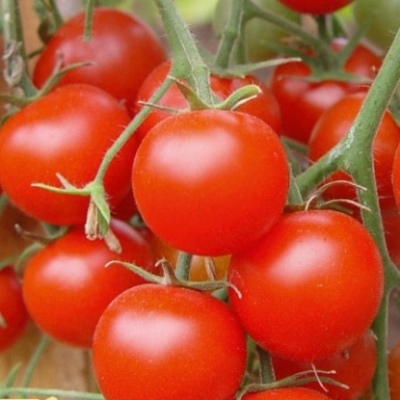
- Authors: Belarus
- Category: grade
- Growth type: determinant
- Appointment: universal
- Ripening period: ultra early
- Ripening time, days: 90-120
- Growing conditions: for open ground, for greenhouses
- Bush height, cm: 40-50
- Bush characteristic: semi-spreading, raised shape
- Ripe fruit color: bright red
Some growers prefer to plant small tomato varieties in greenhouses and open ground that do not require pinching. The crumb is an ideal option for this purpose, with compact bushes and tasty fruits.
Description of the variety
It is not for nothing that the determinant variety of Tiny received such a name. Its bushes grow no more than 50 cm in height. Plants are semi-spreading, raised in shape. When forming, you can leave three stems.
The fruits have a universal purpose, they are very tasty fresh and canned.
The main qualities of the fruit
When the Crumb ripens, its fruits turn bright red. The weight of tomatoes is no more than 40 grams. They are round in shape with a smooth skin.
Taste characteristics
The taste is pleasant, tomato.
Ripening and fruiting
The crumb is an ultra-early variety. Fruits can be harvested after 90-120 days. Harvesting is done in the first two months of summer.
Yield
Productivity with proper care is decent.
The timing of planting seedlings and planting in the ground
Seeds for seedlings should be sown in pots in March or April. Shrubs can be transferred to open ground in May.

Growing tomato seedlings is an extremely important process, because it largely depends on whether the gardener will be able to harvest at all. All aspects must be taken into account, from seedbed preparation to planting in the ground.
Landing scheme
The ideal planting pattern is 70 x 40 cm.

Growing and care
This variety does not require pinching and shaping, which greatly simplifies its care.
The most popular way to grow Tiny tomatoes is open ground. Planting should be preceded by appropriate soil preparation. It is worth knowing that these tomatoes will grow best in clay-sandy soil, slightly acidic, pH 5.5-6.5.
It should be remembered that the Crumb requires a sufficient content of trace elements in the ground, which are necessary for the plant at all stages of the growing season. So that already at the start the seedlings are provided with nitrogen and nutrients, it will be useful to enrich them with manure or prepared compost.
It is better to lay fertilizers in the soil in the fall of the previous season (mixing the soil with fertilizers and digging it up), so that the microelements will have time to penetrate the soil.
The crumb most of all needs nutrients during the period of strong growth and fruit setting. It is during this period that the grower most often deals with the symptoms of deficiency of various trace elements. Well suited as a fertilizer "Florovit" or Azofosk.It is best to choose a liquid formulation that is highly soluble in water, since it is quickly absorbed by plants.
When rolling the leaves, you can apply traditional one-component fertilizers, for example, superphosphate, which gives plants phosphorus and calcium, which affects the correct formation of fruits.
It is good to start feeding tomatoes with mineral fertilizers about 3-4 days after planting, and repeat the procedure two weeks later in the doses recommended by the manufacturer. We do not fertilize when the tomatoes are ripe.
Foliar feeding Crumbs is of great benefit. Thanks to this method, at different stages of the development of the bushes, it is possible to supply the plant with trace elements necessary for normal development.
First of all, a few weeks after planting, the Crumb will need elements such as iron, copper or manganese. It is worth feeding the tomato with mineral water-soluble fertilizers. During flowering and growth, fertilizers rich in boron, phosphorus, magnesium and calcium should be given.
During the period of intensive growth, the Crumb requires about 20 liters per 1 square meter per week. The soil should be moistened down to a distance of 10-20 cm, where there are more roots. In sunny weather, water the tomato in the afternoon or morning, at about 10:00 am. It is best to use settled and warm water for this purpose.
Where the Crumb is grown in greenhouses in large quantities, a drip irrigation system with a timer is used. Thanks to this installation, the soil always remains moist, but not waterlogged. You can use straw-like mulch.




A plant needs different micronutrients at each stage of growth. All fertilizers can be divided into two groups: mineral and organic. Folk remedies are often used: iodine, yeast, bird droppings, eggshells.
It is important to observe the rate and period of feeding. This also applies to folk remedies and organic fertilizers.
Disease and pest resistance
Experienced agronomists talk about the relative resistance of Crumbs to late blight. A fungicide is used for most pathogenic organisms, and an insecticide is used for insects.
Most growers use copper sulfate or Bordeaux liquid to process tomatoes. On the pack you can find instructions for the dosage and use of the funds.
Not bad from folk remedies has established itself as an infusion of garlic, which is used as a prophylaxis against insect infestations. The insecticidal soap solution is also more effective.



























































































